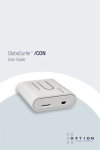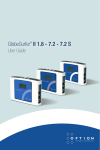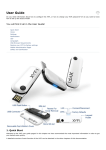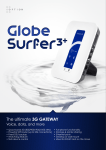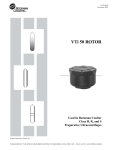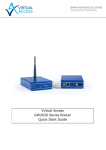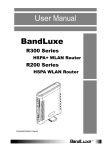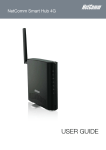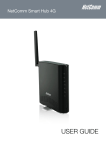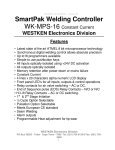Download GlobeSurfer® III
Transcript
GlobeSurfer® III User guide 1 GlobeSurfer® III User guide Welcome to GlobeSurfer® III Welcome to the GlobeSurfer® III, your 3G wireless gateway router that connects you to the internet, allows you to make and receive telephone calls, text messages and enables you to connect USB printers and external hard drives for a truly collaborative life. Within minutes of connecting your GlobeSurfer® III, you can connect to your mobile network and use a wireless connection to the Internet through the 2G or 3G cellular network. GlobeSurfer III is compatible with GSM and 3G mobile networks and supports GPRS, EDGE, UMTS, HSDPA and HSUPA technologies. With ‘Receive Diversity’ on all the high as well as low bands, the signal strength and overall 3G reception is unparalleled. Tip: To achieve the best possible reception, check the signal strength on the display of the unit (the more bars the better the reception). You may find that placing the unit near a window provides the best reception. Simple set-up GlobeSurfer® III provides you with a quick installation and set-up that gets you easily and quickly connected to the Internet. You can use an Internet browser (e.g. Microsoft® Internet Explorer, Safari® or Firefox® *) and most personal computers, including Windows®, Mac OS® and Linux® *. The ‘Quick Setup Wizard’ introduces you to the basic settings that need to be configured for use with the mobile network. Once you have these configured, you can review and enable customised wireless security settings. Instant protection Your GlobeSurfer® III supports Network Address Translation (NAT). This network service hides the computers in your network so they cannot be found or directly accessed from outside your network. A firewall is also included which, by default, blocks incoming traffic and allows outgoing traffic. Additional security GlobeSurfer® III supports both Wired Equivalent Privacy (WEP) and Wi-Fi Protected Access (WPA and WPA2) to protect your network data. Security logs keep you aware of potential security risks and intrusion attempts. You can view logs online or via email. Stay in touch You can use GlobeSurfer® III to send and receive SMS text messages. The display on the front of the unit lets you know when a new SMS arrives. “Notifier” Software If you have installed the “Notifier” software application, then you will also receive a desktop alert indicating the receipt of text messages or telephone calls. The “Notifier” software will also allow you to connect directly to the browser page that handles SMS text messages and telephone calls. When you get a phone call the display shows the caller’s number and indicates missed calls. If you have installed the “Notifier” software application, then you will also receive a desktop alert indicating the receipt of telephone calls, as well as missed calls. The “Notifier” software will also allow you to connect directly to the browser page that handles telephone calls. Important note To protect your network from unauthorised access, and to make it more difficult for hackers to analyse your data, please configure the WLAN security settings and enable WEP, WPA or WPA2 encryption on your GlobeSurfer® III Copyright Important note To protect your network from unauthorised access, and to make it more difficult for hackers to analyse your data, please configure the WLAN security settings and enable WEP, WPA or WPA2 encryption on your GlobeSurfer® III Copyright Copyright © 2008, Option Version 1 Information about Option GlobeSurfer® III may change without prior notice. Information published in this user guide is accurate at the time of publication. Although all security precautions are taken during the creation of this user guide Option is not liable toward persons or organisations for losses or damages caused either directly or indirectly due to instructions contained in this user guide. All brands and registered brands are property of their respective owners. Services may be changed, added or deleted. For the newest firmware version for your GlobeSurfer® III visit http://www.option.com Copyright ©2008 OPTION. All rights reserved. Option, GlobeSurfer, and the Option logo are registered trademarks of OPTION. *All third-party trademarks are the property of their respective owners. 2 3 WARNING •The GlobeSurfer® III is intended for use only when powered by the external power supply shipped together with the equipment or via a replacement power supply available from Option. The use of any other power supply may invalidate regulatory approval of this equipment. Refer to the table below for applicable power supplies. •GlobeSurfer® III is intended for indoor use only and its interconnection points shall not be connected outside of any premises (i.e. outside of any buildings). Refer to the table below for each interconnection point found in this user instruction. •GlobeSurfer® III is regarded a class III equipment where protection against electric shock is provided by means of power supplied from SELV circuit i.e. external power supply and does not generate hazardous voltages within itself. •The GlobeSurfer® III is intended to be used with a POTS (phone) and LAN cable with maximum length of 3 m. If a longer LAN cable is used it must be shielded in order not to invalidate regulatory approval. Applicable power supplies Power supply Manufacturer Model GS2 AC/DC adapter PHIHONG PSA15R-050P Equipment interconnection points Interconnection Category Type DC input connector SELV 5.5/1.2mm DC jack SIM card connector SELV SIM type (ISO7816) External antenna connector SELV MC-CARD type LAN connector SELV RJ45 Telephone connector TNV2 RJ11 Rated Input Voltage Maximum Input Voltage 5 VDC SELV interconnections must only be connected to other equipment that complies with requirements of SELV-circuits as defined in EN60950 directive. TNV2 interconnections must only be connected to other equipment that complies with requirements of TNV2-circuits as defined in EN60950 directive. GlobeSurfer® III User guide 4 5 Contents Your GlobeSurfer® III 7 Buttons and connections 7 The front panel display 7 The main screen 7 Incoming calls 8 Missed calls 8 The display screen saver 8 Getting Started 9 Guidelines for safe and efficient use Positioning GlobeSurfer III 9 9 ® Connect your phone 10 First time use 10 Step 1: Insert the SIM card. 10 Step 2: Connect the power adapter. 10 Step 3: Connect your computer 10 Step 4: Log in to GlobeSurfer III 10 Step 5: Use the ‘Quick Setup Wizard’. 11 Step 6: Enter the PIN code. 11 Step 7: Making your first call 11 Step 8: Connect to the Internet. 12 Step 9: Set the Date and time 12 ® Configure your computers 13 Using Ethernet LAN 13 WLAN connection 13 Everyday Use 14 Staying connected. 14 Making phone calls 14 Using the Graphical User Interface 15 Checking the connection status 15 Login to the Graphical User Interface 15 Changing telephone settings 16 Adding a new user 16 Changing your user name and password 16 Restoring the factory default settings 17 Firmware Upgrade 17 Upgrading From a Local Computer 17 Managing SMS text messages 18 Reading a message 18 Writing and sending a text message 18 Sent SMS text messages 19 Saving a message 19 SMS Templates 19 SMS Settings 19 Text Messages on the SIM Card 19 Administration Basics 20 Quick Setup 20 GlobeSurfer® III 6 User guide Language 20 Telephony 20 UMTS Setup 20 Wireless Setup 21 Wireless Encryption 21 Firewall Setup 22 Save the Setup configuration 22 Security Basics 22 Review the basics 22 Network Address Translation 22 Determine the wireless exposure 22 Firewall 22 Control the traffic 22 IP- Hostname (URL) Filtering 23 Adding a new Web site 23 Modify a Web site address currently in the table 23 Ensuring that all IP addresses to Web-sites in the table are blocked 24 MAC Address Filtering 24 Adding wireless computers to MAC filtering 24 Shared Printers 25 File Server (Attached Storage) 25 The GlobeSurfer III Notifier Software 28 ® Text message receipt 28 Tool-tip 28 Telephone call 28 Glossary 29 Specifications 30 7 Your GlobeSurfer® III Buttons and Connections 1.Left button. Toggles between the features of the device (Signal Strength, Text Messages (SMS), Telephone Calls, Connected Users and USB connectivity). 2. Right button. “On / Off” and “Connect / Disconnect”. Press to connect/disconnect from the 3G network, or hold for 2 seconds to turn the unit off. A single press while the GlobeSurfer® III is in screensaver mode will refresh the screen. 3. SIM Card slot and Restore button a. SIM card slot. Insert or remove the SIM card: press carefully until it ‘clicks’ in or releases. b. Restore defaults. This button is next to the SIM slot. Press it with a pointed object, like a paper clip, to restore the unit to its factory default settings. This may be required when you want to build a new network configuration, or when the administrator password has been lost. i. Note: All web-based management settings and parameters, not only those in the Advanced section, are restored to their default values. The administrator password is no longer valid. All other user names are deleted. All personal configuration settings are deleted, including all SMS messages in the GlobeSurfer® III memory. Messages on the SIM card remain unchanged. 4. External Antenna connector. Enables the connection of an MMX style external Antenna. 5. Local Area Network (LAN). Ports for LAN Ethernet cables to be connected directly into the unit. The LAN connection handles 10/100 Mbit/s. 6. USB Port. Connecting an external hard disk drive (File Server) or USB printer (Printer Server) to this port extends the functionality of the GlobeSurfer® III. a. Please note: This port is only configured for File Server and Print Server functionality – any other USB device connected to the GlobeSurfer® III may not work, and is not supported. Please also note, any external hard disk drive must be formatted in FAT32 or FAT16 file format – NTFS file format is only supported in ‘read only’ mode 7. Telephone. Plug your home telephone into the unit. Base station telephones with remote handsets are supported. 8. DC 5V Input socket: plug in the power adapter DC cable. Tip: Leave the unit on so that you can connect to the Internet at the push of a button, or automatically if that option is selected. The unit is connected when “Connected” shows on the main screen of the GlobeSurfer® III display. The Globesurfer III Front Panel Display 1.The five bars indicate the mobile signal strength. 2.New SMS received. If a blinking red exclamation mark appears next to it, the SMS memory is full. Selecting this icon will display the SMS messages on screen. For multiple SMS messages, continued pressing of the left button will cycle through the messages until all have been displayed. Tip: delete a few messages to leave space to receive more. 3. Phone icon indicates missed calls. For multiple missed calls, continued pressing of the left button will cycle through the missed calls (with telephone numbers if CLI was sent) until all have been displayed. 4. Number of connected computers associated with GlobeSurfer® III via the WLAN. Selecting this option will display the names and IP addresses of the users currently connected. GlobeSurfer® III 8 User guide 5. USB Device. The icon will be ‘Grey’ for no device connected; ‘Red’ for an error or incompatible device connected, and ‘Green’ for active compatible device connected (FAT32 based File Server or Printer Server). 6. The name (or identifier) of your Mobile operator. 7. Connection status. ‘Connecting’, ‘Connected’, ‘Disconnected’. 8. Padlock. Displays whether the WiFi/LAN/WAN encryption security is enabled (padlock ‘locked) or disabled (padlock ‘unlocked’). 9. Mobile connection type: GPRS, EDGE, UMTS or HSDPA. Incoming Calls When you get an incoming call the phone number is displayed: See ‘Making Phone calls’ on page 14. Missed Calls When you scroll across to the ‘Calls’ button, missed calls are displayed. See ‘Buttons and connections’ on page 7. 1. Missed Calls 2. Phone number of missed call. 3. Date and time of last missed call from that phone number. 4. Call sequence number and total number of missed calls. Press the left ‘toggle’ button repeatedly to step through all missed calls until you move on to the next display icon (connected users). The Display Screen Saver A screen saver feature is included to preserve the quality of the display on the unit. When the display is inactive for a short time, the screen saver activates showing a moving image of the current time. 9 Getting Started Guidelines for safe and efficient use GlobeSurfer® III contains sensitive electronic components as used in mobile phones and wireless routers. For safe and efficient use, please follow these guidelines: • Handle the unit carefully and store it in a clean and dust-free place. • Do not expose the unit to liquid, moisture or humidity. • Do not expose the unit to extreme temperatures, either high or low. • Do not expose the unit to open flames or lit tobacco products. • Do not drop, throw or try to open the unit. • Do not paint or place stickers on the unit. • Do not operate the unit near medical equipment without prior permission. • Do not use the unit in areas where radio equipment or mobile phones are prohibited. GlobeSurfer® III. Position GlobeSurfer® III to ensure the following: • A good mobile signal: you may find that placing the unit near a window provides the best reception, however DO NOT place (or leave) the GlobeSurfer® III in direct sunlight as the heat build up due to the sun will damage the device. • A good wireless signal: centrally located and quite high up, or close to a window to optimise wireless connections to computers in both horizontal and vertical directions, allowing wider coverage. Again, DO NOT place (or leave) the GlobeSurfer® III in direct sunlight as the heat build up due to the sun will damage the device • A power outlet is within easy reach. • Ensure that the GlobeSurfer® III is at least 20 cm away from your person. • Keep the GlobeSurfer® III out of direct sunlight and away from heat sources, power lines, fluorescent lighting fixtures, and electrical noise such as radios, transmitters and broadband amplifiers. • Water or moisture must not enter the case of the unit. Connect your telephone You can use a typical corded or cordless home telephone. Plug your phone into the phone socket on GlobeSurfer® III and you are ready to make calls using your mobile subscription. To connect a DECT or wireless telephone you must plug the base unit into GlobeSurfer® III. Note: You cannot connect a mobile phone to GlobeSurfer® III GlobeSurfer® III 10 User guide First time use You need a SIM card from your mobile operator to use GlobeSurfer® III. Please insert the SIM card before you plug in the power adapter. Step 1: Insert the SIM card. Insert the SIM card into the slot beneath the GlobeSurfer® III. Press carefully until it ‘clicks’ into place. Tip: The orientation notch must face downward to the left with the gold plated contacts facing away from you. Step 2: Connect the power adapter. Caution: Use the power adapter supplied with the GlobeSurfer® III. Using a different power adapter can damage the GlobeSurfer® III Plug the power adapter into the 230 Volt AC mains and plug the DC cable firmly into the 5V DC input of the GlobeSurfer® III The unit powers-up within about 30 seconds. Step 3: Connect your computer Note: If your SIM card has a PIN code lock enabled, and you are requested by the GlobeSurfer® III to enter your PIN Code, DO NOT enter the PIN code (yet). The PIN Code should be entered during ‘Step 6’. If no PIN Code lock has been enabled on your SIM card, you will not be requested to enter it. Connect your computer to GlobeSurfer® III using the supplied LAN cable. Note: If you want to use a wireless (WLAN) connection to perform the initial set-up, WLAN must be installed and activated on your computer. For information on how to set up WLAN on your computer, please see ‘WLAN connection’ on page 13. Step 4: Log in to GlobeSurfer® III Start your web browser. Enable cookies or allow them for this address. Type: http://192.168.1.1 in the browser address bar, and press ‘Enter’ or click ‘Go’: The GlobeSurfer® III Management Console opens up with the Login page. Tip: Save the link (URL) to this page as a bookmark in your Browser (follow the instructions in your web browser). Then you can easily access the GlobeSurfer® III Management Console in future by using the bookmark. 11 Select the language you want to use. The ‘User name’ for the default account is ‘admin’, the Password for the default account is also ‘admin’ (or depending on your configuration, the password field should be left blank). Changing the Password, and adding new Users can be achieved in the Quick Start section of the GUI interface. Once the User Name and Passwords are changed, use these next time you are asked to login. Click ‘OK’ to proceed to the Installation Wizard (if connecting to the GlobeSurfer® III for the very first time) or to the ‘Basic’ GUI layout page. Step 5: Use the ‘Installation Wizard’. The ‘Installation Wizard’ guides you through the main settings for your GlobeSurfer® III and, most importantly, gets you connected straight away. Read the instructions on each page and fill in the requested details and click ‘Next’ to carry on. When you get to the ‘Finish’ page, read the summary of the settings you have chosen. Click ‘Finish’ to accept settings and confirm with ‘OK’. Note: Finish the ‘Installation Wizard’ before going on to ‘Step 6’. Step 6: Enter the PIN code. The PIN code is specific to your SIM card. You are now asked to key-in the PIN code: enter the PIN code. Tick the ‘Save PIN’ checkbox: then you will not be asked to enter the PIN again. Click ‘OK’. When you get the ‘PIN OK’ response then click ‘OK’. The Connection page is displayed. Step 7: Making your first call As soon as the operator name shows on the GlobeSurfer® III display, you can make your first call from your home telephone using your mobile subscription. Tip: You can adjust the position of the GlobeSurfer® III to achieve the best possible reception by checking the signal strength on the display of the unit: the more bars the better the reception. GlobeSurfer® III 12 User guide Step 8: Connect to the Internet. From the Browser “Home Overview” screen, click ‘Connect’. Tip: Press the Connect button (right button on front panel) on GlobeSurfer® III as an alternative. The status shows ‘Connecting’ and then ‘Connected’. Open a new browser window and go to a page on the Internet. Step 9: Set the Date and time This information is configured within the Installation Guide, but should you want or need to change it, follow these instructions: 1. Enter the “Advanced Mode” in the GlobeSurfer® III Graphical User Interface. 2. Select the ‘System’ tab from the navigation buttons 3. Select ‘Settings’ from the sub-menu, and ‘Date and Time’ from the right hand side sub-menu 4. Select your time zone from the pull-down menu. GlobeSurfer® III will automatically detect the daylight saving times for the time zone. 5. 12/24 hour mode: Select 12 or 24 hours. 6. Click ‘Apply’ or ‘OK’ to save these settings to GlobeSurfer® III Note: GlobeSurfer® III is configured to synchronise the time automatically using the Network Time Protocol (NTP) and will do so as soon as it connects to the Internet. See the On-line help if you want to know about more ‘Date and time’ settings. 13 Configure your computers Using Ethernet LAN Once GlobeSurfer® III is configured as above, it is ready to be used. If you are only using the Ethernet LAN connection with GlobeSurfer® III, no further configuration is needed. Simply open a new browser window and use your computer to ‘surf’ the Internet with GlobeSurfer® III. If you want to use the wireless connection (WLAN), additional settings are required on each computer that is connected to GlobeSurfer® III via the WLAN. WLAN connection YYour computer must have a WLAN adapter that supports IEEE 802.11 b/g to set up a wireless connection. If encryption is used, make sure that each computer uses the same type of encryption as configured in the ‘Quick Setup Wizard’. For other operating systems, or if your specific WLAN adapter uses any other connection alternatives, refer to the documentation from the WLAN adapter manufacturer. Use the following instructions to connect your computer to GlobeSurfer® III if you are using Windows® XP. 1. Turn on your computer and enable the WLAN adapter, if necessary. 2. From the Windows® ‘Start’ menu, select ‘Control Panel’. 3. Click ‘Network Connections’. 4. Click ‘Wireless Network Connection’ and then ‘Show Wireless Networks’. A list of available wireless networks is displayed. 5. Select the device with the SSID that you entered in the ‘Installation Wizard’, and click ‘Connect’. If encryption is set on your GlobeSurfer® III a dialog box is displayed that requests a ‘Network key’. Type in the same password or encryption key that was entered in the ‘Installation Wizard’ 6. Enter the enter the password or encryption key in both fields and click ‘Connect’. After a short time the message ‘Connected’ is displayed in the dialog box and an icon is displayed in the Windows® XP notification area. In future, your computer will automatically connect to GlobeSurfer® III. GlobeSurfer® III 14 User guide Everyday Use Staying connected. You can use GlobeSurfer® III to make phone calls, surf the Internet and use e-mail just as if your computer is always connected. There is no need to login to the GlobeSurfer® III Graphical User Interface (within the Web Browser) to use those features. If you want to change settings or use SMS then you have to login. See ‘Using the Graphical User Interface’, on page 14. If it does not connect automatically, then use the checklist below to connect your GlobeSurfer® III to the Internet. Step 1: Make sure that the power adapter is connected, GlobeSurfer® III is on and the SIM card is inserted correctly. Step 2: Open an Internet browser on your computer and click the bookmark to GlobeSurfer® III, or type http://192.168.1.1 in the address bar. Note: If this does not work, make sure that your computer is connected to GlobeSurfer® III using either LAN or WLAN. If you are uncertain, check the ‘Network Connections’ in ‘My Network Places’ or in the Windows® Control Panel. Step 3: Enter the PIN code, if requested, and click ‘OK’. The ‘Connection Status’ page is displayed. Click ‘Connect’, or press the connect button on the top of your GlobeSurfer® III, to connect to the Internet. When the connection is established ‘Connected’ shows on the GlobeSurfer® III display and on the ‘Connection Status’ page in the Graphical User Interface. You are now connected to the Internet and you can open a new browser window and start surfing on the Internet. Making phone calls Tip: Do not login if you just want to make phone calls. Just pick up the phone and dial. As long as your phone is plugged in to the unit and your mobile operator name is shown on the display then you can make and receive calls. You can see Incoming call details and missed calls on the front panel display. Tip: Login if you want to change settings or read the list of incoming, outgoing and missed calls. See ‘Changing telephone settings’ on page 16. Using the Graphical User Interface To access the GlobeSurfer® III Graphical User Interface: 1.Open an Internet browser on your computer and click the bookmark link to GlobeSurfer® III, or type http://192.168.1.1 in the address bar. 2. The ‘Home’ page is displayed, showing the ‘Connection Status’ and other basic information. Tip: Do not login if you just want to use the Internet, email or make phone calls. 15 Checking the connection status This information is always displayed when accessing the GlobeSurfer® III browser. • Click ‘Connect’ or ‘Disconnect’ to manually connect or disconnect to or from the UMTS network. Note: The ‘Connection status’ page is refreshed at regular intervals in order to update the information displayed. You can disable the automatic refresh by clicking ‘Automatic refresh off’ on the ‘Connection status’ page but if you do that you will have to click ‘‘Refresh’ whenever you want to see the current status. Note: The connection time and the number of sent and received bytes shown here may differ from that shown on your bill. Login to the Graphical User Interface If you want to change settings or use SMS then you have to login to GlobeSurfer® III. 1. From your browser, type in: http://192.168.1.1 2. Enter your user name and password to login to the GlobeSurfer® III Graphical User Interface. 3. Click ‘OK’. The ‘Home Page (Basic)’ is displayed. The options available to you are as follows: Within the Home view you can see the general overview of the GlobeSurfer® III, as well as view the number of users connected. Quick Setup enables you to enter the necessary information specific to the GloberSurfer® III and the operator you are registered to. This option would be used instead of the Installation Wizard, once the primary setting up of the device has taken place (ie., for all subsequent device changes). Within the Telephone tab you have full telephony controls that are normally associated with fixed line systems, including Call Forwarding. Note that your operator must support this functionality within their network. GlobeSurfer® III 16 User guide Full control over the sending and receipt of text messages. Changing Telephone Settings To change telephone settings from the GlobeSurfer® III Graphical User Interface: Click on ‘Telephone’ and select the ‘Telephone Settings’ sub-menu. From here you can access the telephone settings and see lists of missed, incoming and outgoing calls. • Dialling timeout: type in the number of seconds to set the delay between pressing a dial-key on phone and when the call is placed. • Use # to end dialling: this allows you to press the #-key instead of waiting for the timeout. • Call log: keeps a log of incoming, outgoing and missed calls. Adding a New User You do not need a user account to be able to make and receive phone calls or to surf the Internet. However, you do need to login with a user account to be able to send and receive SMS text messages or use the telephone log. To add a new user: 1. Login to the GlobeSurfer® III Graphical User Interface, if you have not done so already. 2. Enter “Advanced Mode” by selecting it from the horizontal bar on the right. 3. Select ‘System’ from the menu tabs. 4. Click ‘Users’ from the sub-tab. 5.Click ‘New user’ in the User settings page. 6. Enter a new ‘Full name’, ‘User name’, and password. Re-type the new password to verify it. 7. Tick the ‘Administrator permissions’ checkbox. 8. Click ‘OK’ to save the changes. See the ‘Online help’ or the ‘Reference Manual’ for information on how to change the permissions and set email notification. Changing your User Name and Password The password is your security code for the GlobeSurfer® III Graphical User Interface. When logging in to the Graphical User Interface for the first time you have to set a password. If you want to change the user name or password, you can do as follows: 1. Login to the GlobeSurfer® III Graphical User Interface, if you have not done so already. 2. Click ‘System setup’ in the left sidebar. 3. Click the ‘Users’ icon in the ‘System setup’ page. 4. Click on the user that you want to change. The default user is ‘Administrator’ with ‘admin’ as the login user name. 5. Enter the new details in the ‘Full name’, ‘User name’, ‘New password’ and ‘Retype password’ fields. 6. Click ‘OK’ to save the changes. See the ‘Online help’ or the ‘Reference Manual’ for information on how to change the permissions and set email notification. Cannot remember your username or password? 17 You can login to change usernames and passwords, but if you have only one user with administrative permissions and you cannot remember that login name or password, you will have to restore GlobeSurfer® III to the factory default settings. This allows you to accept the default user name and provide a new password in the ‘Welcom page’. Restoring the factory default settings You can restore the factory default configuration for GlobeSurfer® III when you want to build a new network from scratch, or when changes to the network have become unclear. Note: All web-based management settings and parameters, not only those in the Advanced section, will be restored to their default values. This includes the administrator password: the user-specified password will no longer be valid. All personal configuration settings are deleted, including all SMS messages in the unit. Messages on the SIM card remain unchanged. You can restore the factory settings as follows: • On the unit: press the Restore defaults button underneath using a pointed object. • From the GlobeSurfer® III Graphical User Interface: 1. Select the ‘Advanced Mode’ and then chose the ‘System’ tab 2.Select the ‘Maintenance’ followed by ‘Restore Factory Settings’ sub-tabs 3. Read the warning and Click ‘OK’. Then you will need to redo the Set-up as described from ‘Step 3: Connect your computer’ on page 10. Firmware Upgrade GlobeSurfer® III firmware can be upgraded without losing any of your configurations and settings. The firmware is upgraded by downloading a software image file and installing on GlobeSurfer® III. Upgrading From a Local Computer To upgrade GlobeSurfer® III using a locally stored file: 1. Login to the GlobeSurfer® III Graphical User Interface, if you have not done so already. 2. Select the ‘System setup’ icon. 3. Click ‘Maintenance’, and then select ‘Firmware Upgrade’... 4. Enter the path of the software image file, or click ‘Browse’ to browse for the file on your PC and click ‘OK’ when ready: the file will load into GlobeSurfer® III Note: You can only use files with a .rmt extension to perform the firmware upgrade. 5. When completed, a confirmation dialog will ask if you want to upgrade to the new version. 6. Click ‘OK’ to confirm. The upgrade process should take between one to five minutes depending on the size and scope of the firmware changes. GlobeSurfer® III 18 User guide GlobeSurfer® III will automatically reboot and the new firmware version will run, maintaining your custom configurations and settings. Managing SMS text messages The SMS feature works in much the same way as on a mobile phone, with the added convenience of the PC screen and keyboard. To access the SMS feature click the ‘SMS’ icon in the left sidebar. Reading a message GlobeSurfer® III displays an envelope symbol when a new SMS is received. 1. Select the ‘Inbox’ tab to display the messages, with unread message in bold. 2. Click the SMS that you want to read. The message text is shown. 3. When you have read the SMS you can click on: • ‘Reply’: the message text is displayed in the ‘SMS create’ tab with the phone number of the sender already filled in. • ‘Delete’: the SMS is permanently removed without confirmation. • ‘Save to archive’: the SMS is moved to the ‘Archive’ tab. • ‘Forward’: the message text is displayed in the ‘SMS create’ tab ready for you to enter a phone number. To delete an SMS from the list of messages in the ‘Inbox’ tab: 1. Select the ‘Inbox’ tab. 2. Click the ‘Remove’ icon for the message that you want to delete; the SMS is permanently removed without confirmation. Writing and sending a text message To write a text message 1. Select the ‘SMS create’ tab. 2. Type your message text in the ‘SMS message’ field. The Characters left field shows how much space is left. 3. Enter the mobile number of the person you want to contact in the ‘Phone numbers’ field. Use the standard mobile number format: +4976123456 for international, and 076123456 for national numbers. Tip: You can enter several numbers separated by commas (no spaces allowed), up to a maximum of ten phone numbers. 4. You can select the ‘Flash SMS’ - ‘Enabled’ checkbox if you want the message text displayed immediately when received (not supported by all phones). 5. Click ‘Send SMS’ when ready to send. 19 Alternatively you can: • Click ‘Save as draft’ to save in the Drafts folder for completion later. • Click ‘Save as template’ to save the message as a template for future use. Tip: GlobeSurfer® III supports concatenated SMS, which works as follows; if you want to send a longer than standard SMS of 160 characters you can type the almost the equivalent of 4 standard messages (up to 609 characters). When you send the message it will counted as separate messages. Note: When you send an SMS, you may incur a charge depending on your subscription with your mobile operator. Sent SMS text messages The ‘Sent’ tab shows the status of sent messages. The sent SMS is first put in the outbox folder and moved to the sent folder when successfully sent. Tip: Select the ‘Sent’ tab to check that the message has been sent. If the message is still in the Outbox there is probably something wrong with the connection. Saving a message The ‘Archive’ tab is for messages that you want to save. 1. Select the ‘Inbox’, or ‘Sent’ tab, and select the SMS that you want to save. 2. Click ‘Save to archive’. The message is moved to the ‘Archive’ tab. 3. Select the ‘Archive’ tab if you want to see that the message has been moved. See ‘Text Messages on the SIM card’ on page 19. Note: A maximum of 100 messages can be held in the GlobeSurfer® III memory: i.e. totally in the ‘Inbox’, ‘Sent’, ‘Archive’, ‘Templates’ and ‘Drafts’ tabs. SMS Templates Templates can be used when you write messages with similar contents. Then create an SMS with the standard text and save it as a template. To create a new template: 1. Select the ‘SMS Create’ tab to create a new message to use as a template. 2. Click ‘Save as template’ when ready. To use an existing template: 1. Select the ‘Templates’ tab, and then click the message that you want to use.You are then moved to the ‘SMS Create’ tab to change the text and to enter the phone number of the receiver, as required. 2. Click ‘Send’ when ready. SMS Settings The ‘Settings’ tab shows the number to the Short Message Service Centre (SMSC number) which is usually pre-configured on the SIM card by the Internet Service Provider. If required, enter a new number and click ‘OK’. Text Messages on the SIM Card • To read an SMS: 1. Select the ‘SIM card’ tab. 2. Select the message that you want to read. GlobeSurfer® III User guide • To reply to, or forward an SMS: 1. Select the ‘SIM card’ tab. 2. Select the message that you want to edit. 3. Click ‘Reply’ or ‘Forward’: the message text is displayed in the ‘SMS Create’ tab where you can edit and send the SMS. 4. Click ‘Send’ when ready. • To save an SMS: 1. Select the ‘SIM card’ tab. 2. Select a message. 3. Click ‘Save to archive’, to save a copy of the SMS to the Archive tab. • To delete an SMS: 1. Select the ‘SIM card’ tab. 2. Click the ‘Remove’ icon, for the message that you want to delete. The SMS is permanently removed without confirmation. • To delete an open SMS: 1. Select the ‘SIM card’ tab. 2. Select a message to read it. 3. Click ‘Delete’: the SMS is permanently removed without confirmation. Administration Basics The basic configuration of GlobeSurfer® III is done in the ‘Quick Setup’. There may be other configuration settings required in everyday use. These are accessed using the web-based Graphical User Interface as described below. For advanced users and network administrators there are many other settings and parameters that you can change. For example: to set up Virtual Private Networks (VPN), to enable corporate grade security settings, system monitoring and diagnostics. These settings are described in the ‘Reference Manual’. Some information is also available in the ‘Online help’. Click ‘Help’ in the upper right-hand corner of each page to open a new browser window containing help instructions. Quick Setup You can use the ‘Quick Setup’ to change the main settings needed to use GlobeSurfer® III. The following settings can be changed: Language Select the language for GlobeSurfer® III Note: The current language setting will be restored if you do not apply the settings. Telephony Select the country for the telephone handset interface. 20 21 UMTS Setup • Access point name: as provided by your mobile operator. • UMTS Connect Method: • Connect Manually: connect to the Internet by clicking Connect on the Connection Status page in the Graphical User Interface or press the Connect button on GlobeSurfer® III. • Automatically connect upon traffic: GlobeSurfer® III will automatically connect when you attempt to send data via the Internet. • In case of inactivity, disconnect after (minutes): The default is 10 minutes. Set it to zero (0) if you want the UMTS to stay connected. The maximum is 1440 minutes (24 hours). Note: Incoming traffic is treated as inactivity. Wireless Setup The following settings are the most important for the local Wireless LAN: • SSID: The Service Set Identifier: enter a name for your local wireless network (WLAN) (maximum 32 characters). • SSID broadcast: If you set the ‘Enabled’ checkbox to broadcast then other devices can detect and connect to your WLAN. You can install the WLAN with this feature enabled and then disable it once you have set up GlobeSurfer® III and its associated wireless clients. Tip: You can clear this checkbox later to disable broadcasting and hide the name of your network; this provides minimal security, as other devices have to know the SSID to connect. Wireless Encryption Configure the encryption of the GlobeSurfer® III wireless network. The ‘No encryption’ option should only be used during installation of your network to simplify the set-up procedure. Add encryption to your wireless network to prevent unauthorised traffic monitoring and access, as soon as your local wireless network has been set up. Configure your wireless PC clients to use the same encryption type and keys, otherwise the devices will not understand each other. Select from the drop-down list: • No encryption: not recommended except during installation of your network. • WPA: Wi-Fi Protected Access is a 256-bit encryption method with keys that change automatically over time. • WPA2: A more secure version of WPA with implementation of the 802.11i standard. • WPA and WPA2: A combination of both security protocols listed above. • 802.1X WEP: Wireless Equivalent Privacy is a 64 bit or 128-bit encryption method with user configurable fixed keys. 128-bit provides higher security. In 802.1X WEP, a radius server is used to perform authentication, contrary to regular WEP • WEP: Wireless Equivalent Privacy is a 64 bit or 128-bit encryption method with user configurable fixed keys. 128-bit provides higher security. • Authentication Only: Any user accessing web pages through Wireless LAN will be redirected to the web GUI and asked to authenticate himself before being able to access other web pages. This authentication only needs to be performed once every session. Note: Not all wireless client equipment supports ASCII-text format. If you are experiencing problems, use the hexadecimal key format since most vendors support it. Note: WPA/WPA2 is recommended as it provides a higher level of security due to the longer key that changes automatically. Configuring WEP: • Key Type: Select the encryption level from the drop-down list. • Pre-shared key: Type in the hexadecimal 26 characters, or a plain text (ASCII) pass-phrase of 5 or 13 characters. Configuring WPA or WPA2 encryption: • Key Type: Select the encryption level from the drop-down list. • Pre-shared key: Type in the hexadecimal 64 characters, or a plain text (ASCII) pass-phrase of at least 8 characters. Note: Advanced options for encryption configuration are available via the icons ‘Connection Settings’, ‘Network Connections’. Wireless encryption has no security effect on wired (Ethernet) connections. GlobeSurfer® III User guide Firewall Setup The GlobeSurfer® III firewall has three pre-defined levels of security. The default, ‘typical security’, blocks traffic initiated by an external (Internet) source, and allows traffic initiated from the local network. For advanced configuration of your firewall security parameters, please refer to the ‘Reference Manual’. Save the Setup configuration Save the new configuration by clicking ‘OK’ or ‘Apply’ and then ‘OK’ to confirm. If using the ‘Quick Setup Wizard’ save the new configuration by clicking ‘Finish’ and then ‘OK’ to confirm. Note: Browser reload: You may need to reconfigure connected computers and reload the GlobeSurfer® III Graphical User Interface page. Security Basics Review the basics Just connecting your computer to GlobeSurfer® III provides a basic level of protection because it supports Network Address Translation (NAT). Network Address Translation Your GlobeSurfer® III supports NAT. This network service makes it possible for all of the computers in your network to share a single IP address. This IP address is assigned to your GlobeSurfer® III and is the only address that is visible to the outside world. The private addresses that DHCP assigns to computers in your network remain private and cannot be reached from the Internet. Determine the wireless exposure If you live in a rural area far away from your neighbour, the likelihood that someone will break into your wireless network is very low. On the other hand, if you live in a densely populated area in the city next to an office building, there is a potential danger that a third party may try to access your WLAN. Based on your own security needs, decide which security settings you want to implement: • Change SSID • Disable SSID broadcast • Enable WEP, WPA, or WPA2 encryption These settings are available from the ‘Quick Setup’ page of your GlobeSurfer® III. Each computer to be connected to your WLAN must use the same settings. Furthermore, you can enable MAC filtering on GlobeSurfer® III. MAC filtering can be used to grant or deny WLAN computers in your network access to GlobeSurfer® III based on the MAC address of the computer. For further information see ‘MAC Address Filtering’, on page 24. Firewall Your GlobeSurfer® III has a true firewall that uses rules to control the incoming and outgoing data traffic. The firewall has three pre-defined levels of security. The default, ‘typical security’, blocks traffic initiated by an external (Internet) source, and allows traffic initiated from the local network. Control the traffic A firewall blocks uninvited Internet traffic that might cause damage to the computers in your network. Before traffic is allowed in or out of your network, it has to pass through the firewall. Incoming traffic is examined to see whether it meets the conditions of incoming rules. If the conditions are met, the traffic is allowed in. Outgoing traffic is also examined and compared to outgoing rules before it is allowed out. Rules are based on Internet services, such as FTP, Telnet and NetMeeting. Is it necessary to change the default firewall rules or add new rules? For private use, you should not have to add new rules or change the default rules. By default, all incoming traffic is blocked and all outgoing traffic is allowed. If you set up a virtual server, an additional incoming rule is automatically added to enable access to the server from the Internet. 22 23 An example of an attack that your GlobeSurfer® III will automatically block is a Denial of Service (DoS) attack. This is an attack where a hacker chooses to flood your network with more requests than it can handle. While this type of attack would not harm computers in the network, it could slow or even stop network operations. You do not need to set up a firewall rule for this. More information about the firewall and applying corporate grade security is provided in the ‘Reference Manual’. IP- Hostname (URL) Filtering You may configure GlobeSurfer® III to block specific Internet sites so that they cannot be accessed from computers in the local network. Moreover, restrictions can be applied to a comprehensive, automatically updated, table of sites. To view the table of Web sites currently being blocked: click the ‘Services’ and ‘Firewall’ icons and select the ‘Website Restrictions’ tab. Adding a new Web site 1. Click ‘New Entry’. The ‘Restricted Website’ dialog will appear. 2. Enter the IP address or URL of the web site that you want made inaccessible from your local network; all pages within the site will be blocked. If the web site address has multiple IP addresses then GlobeSurfer® III will resolve these and add them to the restrictions table. 3. You can apply the filtering rule to all computers, or a specific one or a group. From the ‘Local host’ drop-down list you can select ‘Any’ (i.e. all computers), a named computer or group from the list, or ‘User defined’ to create a new group. To learn how to create groups and apply rules see the ‘Reference Manual’. 4. Rules can follow a specified timetable. From the ‘Schedule’ drop-down list, you can select a pre-defined schedule or click ‘User defined’ to create one. To learn how to create a new time schedule, see the ‘Reference Manual’. 5. Click ‘OK’ to add the web site to the table. You will be returned to the previous screen while GlobeSurfer® III attempts to find the site. ‘Resolving…’ will appear in the Status column while the site is being located (the URL is being ‘resolved’ into one or more IP addresses) then ‘Resolved’ will appear. Tip: Click ‘Refresh’ to view the new status. If the site cannot be found, the status ‘Host name resolution failed’ will appear. Try to access the site using your web browser: • If you can verify that the site is available, then you probably entered the address incorrectly. See ‘Modify a Web site address currently in the table’ on page 23. • If you cannot verify that the site is available then wait and try later: return to the ‘Restrictions list’ screen and click ‘Resolve now’ to verify that the Web site can be found and blocked by GlobeSurfer® III. Modify a Web site address currently in the table 1. Click the ‘Edit’ icon in the ‘Action’ column to open the ‘Restricted website’ dialog. 2. Modify the ‘Restricted website’ address, ‘Local host’ and ‘Schedule’ as required. Tip: Copy and paste the address from the browser address bar to the Graphical User Interface, leaving out the “http://” at the beginning and the “/” at the end of the address. 3. Click ‘OK’ to save the changes. GlobeSurfer® III User guide Ensuring that all IP addresses to Web-sites in the table are blocked From the ‘Web Restrictions’ tab, click ‘Resolve now’. GlobeSurfer® III will ensure that all IP addresses at each web site address in the table are included. You may disable a restriction and make a web site available again without removing it from the ‘Restrictions list’. This way you can make the site temporarily available when you expect to block it again later: • To disable a restriction, clear the checkbox in the ‘Local host’ column next to the restricted URL. • To re-enable the restriction, tick the checkbox. To remove an item from the Restrictions list, click the ‘Remove’ icon in the Action column. MAC Address Filtering A common method of restricting WLAN network access is to specify the Media Access Control (MAC) address. Every WLAN network adapter is identified by its MAC address. Specifying which computers can connect to your network can limit network access to trusted computers. GlobeSurfer® III supports MAC filtering based on a list of denied or allowed computers. MAC filtering mode ‘Allow’ specifies that the list of MAC addresses is granted access to GlobeSurfer® III. MAC filtering mode ‘Deny’ specifies that all computers except those in the list of MAC addresses are granted access to GlobeSurfer® III. Before you set up your list of trusted MAC addresses, you have to know what they are. A device’s MAC address is usually found on a sticker on the bottom of the device. For internal wireless PCI cards, refer to your operating system documentation for instructions. You can also type ‘ipconfig /all’ in the ‘Command Prompt’ in Windows® to locate the MAC address. The MAC address displays as the physical address. Adding wireless computers to MAC filtering 1. Enter the ‘Advanced Mode’ and then chose ‘Local Network’ _ and ‘Wireless’ _ from the menu tab and sub-menu. 2. Select ‘Advanced’ from the right hand menu tabs _ and finally the ‘Wireless’ tab _ to open ‘LAN Wireless properties’. 3. Select ‘New MAC address’. 4. Enter the MAC address of the WLAN computer and click ‘OK’. 5. Select ‘MAC filtering mode’: Click ‘Allow’ or ‘Deny’. (Select ‘Disable’ if you want to disable MAC filtering.) 6.Click ‘OK’ at the bottom of ‘Configure LAN Wireless’ to apply your settings 24 25 Shared Printers GlobeSurfer® III includes a print server that allows printers attached to the device via the USB connection to be shared by all computers on the LAN. To configure a network printer, select the “Print Server” option from the Home screen. The ‘Printer’ screen appears, where you can view information about your printer, as well as view a list of print jobs (when prints are in the queue). File Server (Attached Storage) GlobeSurfer® III includes a file server function that allows external hard disk drives to be attached to the device via the USB port. Once the external disk drive is connected, it can be shared by all computers on the LAN. Please note that the external hard disk drives must be formatted as “FAT” (File Allocation Table) format in order to read and write to the disk. NTFS (New Technology File System) format is supported for ‘read’ only, and will not enable you to write to the disk. t is possible to re-format your external hard drive in FAT32 format through the GlobeSurfer® III device if you require read/write functionality. Please note: External Hard drives that require power over their USB cable (ie., are not independently powered) should be connected to the GlobeSurfer® III while it is turned off or there is a risk the sudden power surge required to start the external hard drive may cause the GlobeSurfer® III to ‘hang’. USB ‘memory stick’ storage devices can be connected to the GlobeSurfer® III at any point (ie., while the GlobeSurfer® III is turned on or off). To add an external hard disk drive to the GlobeSurfer® III device, and use it via the LAN, follow the steps below. 1. Power off the GlobeSurfer® III if the external hard drive is powered via USB cable 2. Connect the external hard disk drive, and then turn on the GlobeSurfer® III. 3. Log in to the browser Graphical User Interface. 4. Select the “File Server” icon from the Basic or Advanced Home Screen. GlobeSurfer® III 26 User guide Once you insert your external hard drive to the USB port on the GlobeSurfer® III, the browser will refresh to show the presence of the external device. Select ‘Share’ in order to publish your external hard disk drive on the LAN. Selecting ‘Share’ will create a link to your external hard drive, and should open a new client window showing the contents of your external hard drive. In order to configure your external hard drive device so that it is available every time you insert it into the GlobeSurfer® III, then select “Map Network Drive” from the Tools menu and assign a drive label (such as ‘G:’). 27 Please note that external hard disk drives must be formatted as “FAT” (File Allocation Table) format in order to read and write to the disk. NTFS (New Technology File System) format is supported for ‘read’ only, and will not enable you to write to the disk. It is possible to re-format your external hard drive in FAT32 format through the GlobeSurfer® III device if you require read/write functionality. Please note: Due to the single USB port on the GlobeSurfer® III device, it is highly recommended that external hard drives be separately powered. For external hard drives that require power over their USB cable, it is highly recommended that the hard drive be connected to the GlobeSurfer® III device while the GlobeSurfer® III is turned off. In the event an external hard drive is connected to the GlobeSurfer® III while it is turned on, the sudden power drain on the GlobeSurfer® III device while the external hard drive initially powers up, may cause the GlobeSurfer® III to hang. GlobeSurfer® III 28 User guide the GlobeSurfer® III NotIfIer SoftWAre The GlobeSurfer® III now comes with its own software package (contained on the CD) that enables clients to take full advantage of the features of the gateway router, without needing to have the device resident on the desks, by their PC’s. Due to its very nature, the GlobeSurfer® III could easily reside on a wall, on a remote desk, or in another room entirely, where the signal strength is optimised, therefore there is a good chance the GlobeSurfer® III colour display is out of the users view. With this in mind, the “Notifier” software has been developed, so clients can still be alerted to events as and when they occur. Once installed, the “Notifer” will reside in the client system tray, and will wait for events to occur. An event could be a text message being received, a telephone call being received/missed, or important information about the well-being of the GlobeSurfer® III device (such as firmware updates). 1. Text message display: shows the text message received, the originators number being displayed above the message. 2. Missed calls received: displays the call line identity (if sent) and the date/time of the missed telephone call. Multiple missed calls can be scrolled through by pressing the left/right arrows on the right hand side. 3. Device characteristics: Information relating to the operating environment of the GlobeSurfer® III device; Operator name and Number of connected users. 4. Text message scroll arrows: As with telephone calls, by pressing the right/left arrows clients can scroll through current and previous text messages. 5. Signal strength and 3G or 2G connection status. Text message receipt When the GlobeSurfer® III receives a text message, the “Notifer” software will display an alert on the client desktop. This alert will display the contect of the text message, including the number the message originated from. The client can select the message alert, by clicking on it, and will then be forwarded to the Text Message facility within the web browser, in order to reply to, or delete the message. Tool-tip If the client ‘hovers’ the mouse over the system tray icon, information relating to the operating status of the GlobeSurfer® III will be displayed, eg Operator, 2G/3G status and signal strength. status and signal strength. Telephone call When the client receives a telephone call, the “Notifier” will alert them with another pop up display, showing the originators telephone number. 29 Glossary • 802.11b WLAN standard. Provides a transmission speed of up to 11 Mbps in the 2.4 GHz band. • 802.11g WLAN standard. Provides transmission speeds of up to 54 Mbps (typically 22 Mbps) in the 2.4 GHz band. Is considered a successor of, and is compatible with, 802.11b. Enables high-speed data access from up to 100 meters distance from the base station. • DHCP Dynamic Host Configuration Protocol. The Dynamic Host Configuration Protocol is used to configure IP addresses and applicable information dynamically. Instead of a fixed IP address, DHCP clients receive their IP address from a central DHCP server. • DNS Domain Name System. Internet service that is used to assign IP addresses to the corresponding readable domain name and vice versa. • Dynamic DNS Dynamic Domain Name System. Provides assignment of dynamic IP addresses to fixed domain names. • EDGE Enhanced Data rates for Global Evolution. An enhancement to GSM that increases data throughput. • Ethernet The most widely used local area network (LAN) access method defined by the IEEE as the 802.3 standard. Originally developed by Xerox to link minicomputers in the Palo Alto Research Centre. • Firewall Technology in the form of hardware or software that controls the flow of data between a private and an unprotected network (LAN and Internet, respectively) or protects an internal network from attacks from the Internet. • Firmware Pre-installed software to operate GlobeSurfer® III. • FTP File Transfer Protocol (FTP) regulates file transfers on the Internet. • GPRS General Packet Radio Service. An enhancement to the GSM mobile communications system that supports data packets. GPRS enables continuous flows of IP data packets over the system for such applications as Web browsing and file transfer. • GSM Global System for Mobile Communications. A digital cellular phone technology that is the predominant system in Europe, but is also used around the world. Operating in the 900MHz and 1.8GHz bands in Europe and the 1.9GHz PCS band in the US. • HSDPA High Speed Down-link Packet Access. An enhancement to 3G technology that increases the down-link speed. • HSUPA High Speed Up-link Packet Access. An enhancement to 3G technology that increases the up-link speed. • HTTP Hypertext Transfer Protocol is a service protocol to transmit documents between servers or from a server to a client. Is mainly used on the Internet, or the World Wide Web. • IP address The IP address identifies every device connected to the Internet through an address that is unique. • LAN Local Area Network. Local computer connection that has few or no connections to the outside world. • MAC address Media Access Control (MAC) address. A 48-bit identification number of a network card that generally cannot be changed. Shown as a hexadecimal number. • NAT Network Address Translation (NAT). Method to convert (mostly private) IP addresses of a network to other (mostly public) IP addresses of another network. • Network adapter Another word for Network card. The network card is the device that establishes the connection between the network (wireless or wired) and the computer • Network name See ‘SSID’, below. • Pass-phrase A pass-phrase is used as an encryption password and is generally longer than an ordinary password and may contain letters and numbers. • Port Describes an interface between the operating system, applications and the Internet. • SMTP Simple Mail Transfer Protocol. E-mail programs use SMTP to transmit data to the mail server. It then forwards the e-mail via intermediate stations to the recipient’s mail server. • SSID Service Set Identifier; network name in WLAN which allows stations in the WLAN to find the correct access point. • TCP/IP Transmission Control Protocol / Internet Protocol; this is the transport protocol on which the data transmission on the Internet is based. • UMTS Universal Mobile Telecommunication System. A global standard for third generation (3G) mobile technology. UMTS in its initial phase offers bit rates of up to 384 kbps, both up-link and down-link. • URL Uniform Resource Locator is an Internet address, such as www.google.com. • WAN Wide Area Network is a network mainly working across great distances. • WEP Wired Equivalent Privacy; describes a 64 or 128 bit encryption process used for wireless LANs. • WLAN Wireless Local Area Network is a remote technology for wireless networking. • WPA Wi-Fi Protected Access is a 256-bit encryption method for a WLAN. • WPA2 A more secure version of WPA with implementation of the 802.11i standard. GlobeSurfer® III User guide Specifications • UMTS FDD UMTS, 850/900/1700(AWS)/1900/2100 MHz variants. HSDPA speeds up to 7.2 Mbps HSUPA speeds up to 5.76Mbps • LAN Ethernet 10BaseT/100BaseT, Auto MDIX • WLAN IEEE 802.11 b/g WLAN • Security 64 bit and 128 bit WEP Encryption WPA/WPA2 Encryption Port and URL Filter DMZ Support Firewall, three predefined levels VPN tunnelling, PPTP, Ipsec, L2TP • Display Colour 128 x 128 Pixel display (65k colours) Status information New SMS Received Missed/Incoming calls Current time (hours:minutes), clock synchronisation over the Internet (NTP) Signal strength Number of WLAN connections Screen saver • Buttons Left Button to toggle through menu items (Home, SMS, Telephone, Connected Users and USB) and Refresh from Screen Saver. Right Button to Power On/Off; Connect/Disconnect UMTS and Refresh from Screen Saver • Connectors Power connector USB Port RJ-45 Ethernets RJ-11 POTS telephone SIM card holder External antenna connector (GSM/UMTS) • User Interface Device configuration with local web browser (no software installation required) • Power adapter Input 110-240V, 50-60Hz Output 5V DC, 2.4A • Dimensions 155 x 120 x 35 (W x H x D in mm) • Weight 255g, excluding power adapter • Operating Environment Indoors 0 °C – 60 °C Humidity 5% – 95% 30 31 GlobeSurfer® III. Questions and answers can be found on our Support web-site: http://support.option.com/support/faq.php To register please go to: http://support.option.com/support/register.php To post technical questions after you have registered please use the online support at: http://support.option.com/support/newticket.php GlobeSurfer® III User guide 32 1 Gaston Geenslaan 14 - 3001 Leuven Belgique - T +32 16 317 411 - F +32 16 207 164 - www.option.com


































